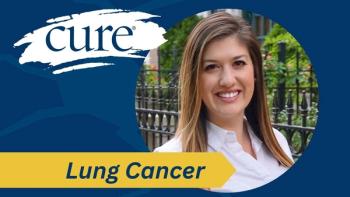
From a Halfway House to Cancer Treatment: My Family Helped Me Live With ‘Profound Purpose’ After a Leukemia Relapse
After breaking 20 years of sobriety, I received even worse news: my leukemia had relapsed, and I’d need a bone marrow transplant. Thankfully, my family and treatment team lifted me up during this difficult time.
In January of 2020, the nasty COVID-19 pandemic started, and I just got out of rehab after a relatively short but ugly relapse on alcohol, breaking 20-plus consecutive years of sobriety. One of the propellants (read, “excuses”) to my relapse was the recent loss of my dog, Payton.
I was divorced and had no children. I lived in a gross halfway house as recommended by my dependency treatment team, and I was looking for a new job. I was again fresh and sober and eager to experience life again, albeit tepid about my future.
But then, everything changed. I went into Moffitt for my six-month check-up after rehab and came out with a cancer relapse diagnosis.
The shocking news that my acute myeloid leukemia returned was humbling, horrible and heartbreaking. I expressed my disbelief to Dr. Sallman at Moffitt Cancer Center at a follow-up visit after the diagnosis.
I asked, “Is this really happening?” He softly replied “Yes, that was such a bad day,” in reference to when the leukemia was confirmed through a bone marrow biopsy. He said this in a state of self-reflection and sadness.
He simply had innate authentic compassion. This remains a small but impactful golden moment.
However, my worst day with cancer was better than my "best day" drunk. I would rather have leukemia than lose my soul with alcohol. That's how much I loathe the prison that is addiction.
My Family Lifted Me Up After My Diagnosis
Upon hearing of the cancer recurrence, my family lifted me up. Way up, like only a loving family can. They were like floating busybody haloes. I loved them to death, so I got ready to live. I summoned faith in my higher power, who already got me through so much. My determination was not consistent, but my doctors and my family made the shallow moments brief.
The clinicians at Moffitt presented options. I decided on the recommended and most vigorous course of treatment: a bone marrow transplant. First, I would receive induction to tackle the cancer cells pre-transplant. I would then be sent home to wait while the Moffitt team researched possible donors.
My Moffitt team informed me that in order to receive the transplant there, I would need to find residency within 15 minutes of the main campus or find a nearby hotel. This is because a patient may experience life-threatening complications post-transplant and would need immediate attention. My residence at the time was a moldy old sober living home — a place I refused to eat in, as cockroaches had kitchen cabinet apartments.
I was fortunate that my brother Chris and sister-in-law Anne lived in a large, beautiful homeclose to Moffitt’s Magnolia campus. They generously offered the invitation; I did not have to ask. So, after induction, I moved into their lovely home. My younger brother Danny also just moved from Milwaukee into their home, so we made a cozy foursome.
My dear sister Julie in Atlanta and my best friend and sister Amy in Wisconsin called and Zoomed often to generously share their unlimited love and support. My parents, also in Wisconsin, were pillars of strength. My mom is one of the world’s best listeners and comforters. My father is a wealth of information as a retired physician and a holy man. Unfortunately, COVID-19 prevented anyone from traveling.
Chris, my older brother, took on the role of being my main caregiver. A saint.
My siblings were tested to see if any one of them could be the bone marrow donor. Unfortunately, no one was a match. The pandemic put a hamper on the search, for many candidates were overseas.
Then, after four months of waiting and intermittent chemotherapy, an analogous donor was finally found! I do not pretend to know all the people that were involved in getting this donation to me in time during the pandemic so that I would have a shot at life. My gratitude is enormous. My donor is an angel.
During induction, Dr. Lia Perez, my lively, beautiful and brilliant bone marrow transplant physician, delivered a wealth of information on what to expect during and after the transplant. She was not shy of delivering the likely side effects, the details on graft-versus-host disease and the morbidity rates. But she strongly encouraged me to ignore the stats. I was not a statistic.
On June 5, 2020, I received my transplant.
To my surprise, chemo was not only infused prior to the transplant, but another variety was administeredright after the transplant.
The transplant itself was uneventful. However, the stem cell infusion combined with the cauldron of chemotherapies kicked me in the butt. Like many patients, I lost my hair; I had ugly and terrible mouth sores; I broke out in a rash again; I had nausea and vomiting spells; I lost a lot of weight; my skin became “prickly” until it molted; my nails fell off while new nails grew in; and my optimism was challenged every day.
I prayed and painted the pain away. (My watercolor started by drawing my sister Amy in a green onesie with a top hat, and my sister Julie as a free spirit in flowing pants. I was the onlooker. So started “The Sister Series: My Early Years.”)
I would conjure strength through gratitude for my family, my cancer team, my sobriety and God. I learned that you don’t know how strong you are until you must be as strong as you can be.
Here’s what blew me away: Before each step of the treatment process, a physician or member of the Moffitt clinical staff clearly explained what was to be done, why, and how it may affect me physically. These busy experts acted like they had all the time in the world.
Often, they would use markers on whiteboards all over my room to draw pictures or define terms so I would comprehend complicated treatments. They were never patronizing. They would not leave until all my questions were answered. I would even videotape these presentations, albeit with hidden talking heads for confidentiality, to share my education with my family. Dare I say that this was actually fun? I was educated, entertained and treated like I mattered.
My transplant physician, Dr. Lia Perez, was a Godsend. She was not only an excellent physician, Dr. Perez was full of life, love and honesty. I recall feeling very unattractive with my thinning hair and gaunt face.
Dr. Perez entered the room. “Hello Princess! You look beautiful! I love the color of your hair…are those gold highlights?” I’d proudly reply, “the color (of these 13 hairs) is my natural color!” When my hair later grew back gray, she would say “Hello Princess! You look beautiful! Your hair is the color of pearls and diamonds. I love it!”
Recovery Takes a Team
After returning home, I gently, yet determinably, embarked on a mental, physical and spiritual recuperation and improvement trip. My goal was to become supremely exceptional and live a life with profound purpose. I would embark on invigorating walks; I’d head out the door and down the drive. Then it was nap time.
I started to eat more, even though my sense of taste took a while to come back — for a long time, most food tasted like rotten garbage with metal-based condiments. Despite having compromised tastebuds, I decided to learn how to cook, much to the chagrin of my family. Tomatoes smelled like they were from the junkyard, but I would still make spaghetti.
With my newfound love of water painting, a 24-session online Zoology course to feed my passion for wildlife, small frequent walks, my physical therapy and my lousy-but-improving baking and cooking, and lots of love from my family, I recovered.
I’m deeply grateful for the resources I've had throughout my experience. The Leukemia and Lymphoma Society took care of my insurance co-pays and gave me access to online support groups. Moffitt’s Magnolia Salon helped me with head covers and wigs to gain confidence. Moffitt’s art room, massage and acupuncture services, and amazing support groups nourished my soul. Their social workers and volunteers gave me a place to safely share my hopes and fears as they related to cancer. And I am grateful for the rooms — including Zoom rooms during COVID-19 — of Alcoholics Anonymous for helping me evolve.
Connecting With My Donor
Per the stem cell matching agency, the donor and recipient can choose to communicate one year out from the transplant. My donor and I both agreed to connect in July of 2021.
I was sent an email and a reply came swiftly. I met the most beautiful, brave, generous 23-year-old woman from Israel.
She just got back from Costa Rica, one of my favorite places. We both love wildlife and all animals. She was supposed to go to Africa as a volunteer the year I got my transplant, but COVID-19 stopped her. I volunteered in Africa working with rescued elephants in a sanctuary. She had two sisters and drew pictures of them, just like my Sister Series. We have much in common, but she is by far much more exotic.
I Googled her village in the West Bank and saw stunning old-world charm, beauty, nature, history and mystery. The rolling hills and white domed homes are a far cry from the flat roads and strip malls near me, though we do have lovely beaches here in Florida. She is fascinating and precious.
Someday we hope to meet in person. I was raised Roman Catholic and now I am proud to also have Jewish blood.
I am now living life post-transplant and am doing remarkably well. I got a fun job selling fine and fashion jewelry for Nordstrom. In the spirit of giving back, I am humbly trying to emulate all the caregivers who helped me. I am a proud volunteer member of Moffitt’s Patient and Family Advisory Council. I am a volunteer mentor for Imerman Angels. And I am honored to be a Comfort Care Companion for certain Moffitt patients at the end of life.
This post was written and submitted by Mary Sansone. The article reflects the views of Mary Sansone and not of CURE®. This is also not supposed to be intended as medical advice.
For more news on cancer updates, research and education, don’t forget to




